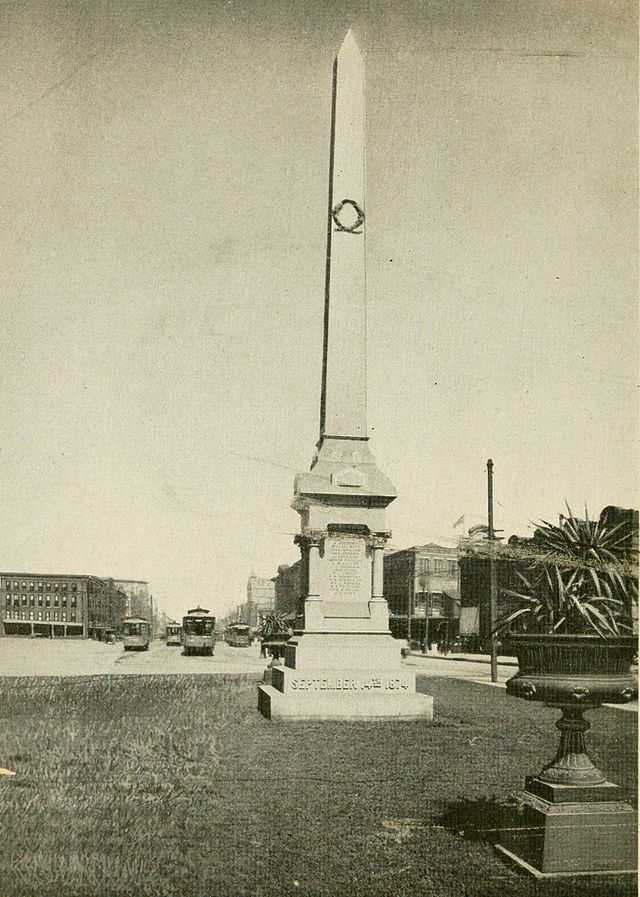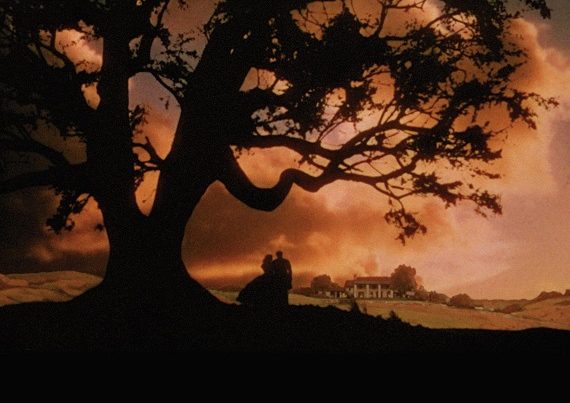
Although commonly portrayed as one of the largest mob attacks on blacks by white racists during Reconstruction, the so-called 1874 Battle of Liberty Place in New Orleans was really a conflict between the militias of two competing state governments.
The story begins in 1868 with the election of Carpetbagger Henry Warmoth as Louisiana’s first elected Republican governor. To ensure future Republican victories at the polls, in 1870 his legislature established a five-man Election Returning Board, which had final authority to determine the outcome of all major elections. It is perhaps the most egregious example of how Reconstruction-era Republican Puppet Regimes used control of the election machinery to force their will on the people.
At the end of Warmoth’s four-year term in 1872 the state’s Republican Party split for two reasons. First was an internecine fight over the distribution of political patronage within the state. Second, was a consequence of a split in the national Party between “stalwarts” and “liberals.” The stalwarts backed President Ulysses Grant whereas the liberals wanted civil service reform to minimize patronage corruption. Nationally, the Democrats joined the Republican liberals in backing Horace Greeley for President.
Similarly, in Louisiana Henry Warmoth’s liberal Republicans backed Democrat John McEnery for governor and David Penn for Lieutenant Governor. The state’s stalwart ticket consisted to William Kellogg for governor and Cesar Antoine as his running mate. The Kellogg team was known as the “custom house” faction because Kellogg was previously the tariff collector for the port of New Orleans. Moreover, the then-present collector was James Casey, a brother-in-law to President Grant. During the nineteenth century customs collectors produced most of the Federal tax revenue and were notoriously corrupt.
The election took place on November 4, 1872. When Warmoth convened the Returning Board to certify the winner on 13 November he was dismayed to learn that Kellogg representatives challenged the membership. Through a torturous series of court cases Kellogg felt he had authority to set up his own Returning Board. The result was two opposing Boards. One, managed by Warmoth, supported McEnery. The second, managed by state Senator John Lynch, supported Kellogg. Since Lynch’s Board had no ballots to count, they created vote tallies out of thin air. Lynch got the results Kellogg wanted by using as “returns” affidavits, newspaper estimates, and even their own calculations from general knowledge of what a vote in each parish might have been. Predictably, on December 4th Warmoth’s Board announced McEnery the winner. Two days later Lynch’s Board declared Kellogg the winner.
The true winner will never be known. There was fraud on each side, but especially Kellogg’s. Even though Warmoth held the state’s election machinery, the Kellogg faction controlled the Federal election supervisory machinery under the new KKK Enforcement Acts. They named numerous supervisors in every parish and deployed six hundred special marshals in New Orleans alone.
Affidavits made by black voters who were allegedly denied the vote were printed in blank by the thousands before the election and signed in bulk by obliging officers. The special marshals engaged to complete them had only to dig up names, from any convenient source, and fill in the blanks. Lynch’s Board counted each fraudulent affidavit as a vote for Kellogg.
On December 5th Federal judge Henry Durrell ordered U.S. Marshalls to seize the statehouse, then in New Orleans. The following day Federal troops only allowed Kellogg men to enter the offices. In response, McEnery’s Democrats set up their own state government at Lyceum Hall in the New Orleans municipal building.
For the next ten months Louisiana would have two state governments. One propped-up by Federal marshals and soldiers and the other supported mostly by the state’s whites. Two years after his December 1872 ruling, the Republican-controlled House Judiciary Committee in Washington voted to impeach judge Durrell for systematic bribery and for exceeding his authority in the 1872 elections. He resigned before the full House drew-up impeachment articles.
Louisianans soon realized they were confronted with two competing state governments, each expecting taxpayer support. Thus, taxpayers did not know which government should be paid when tax bills arrived. When each government selected a new U.S. Senator, the problem got kicked up to the Senate in Washington because that body would have to choose between the state’s two new designees thereby indirectly validating one of the legislatures and nullifying the other.
Although today’s student might suppose that the GOP-controlled Senate would choose the Republican candidate, it didn’t. As the senators researched the election they were appalled at the manipulations and refused to seat either Louisiana designee. The U. S. Senate concluded that Louisiana should hold new elections, a decision that caused riots between the two sides in Louisiana. That forced President Grant to make a choice. Even though the President and his Cabinet agreed that Kellogg was “a first-class cuss” Grant chose to back him, perhaps because the President’s brother-in-law was on the Kellogg team.
Eventually the two state governments formed their own militias. Kellogg’s was composed of blacks and the New Orleans police while McEnery’s was mostly white volunteers from organizations such as the White Leagues. It was those two forces that clashed at Liberty Place in September 1874. Neither was a disorganized mob. Unlike the Ku Klux Klan the White Leagues were not secretive. In some parishes they did little more than hold anti-Kellogg rallies. In others, such New Orleans, the chapter’s 3,000 members were well-drilled and militant. Their leaders explained that the movement was “an inevitable result of that formidable, oath-bound, and blindly [Republican] obedient [Union] league of the blacks.”
In July 1874 Kellogg passed a bill that gave the governor even more power to dictate election results by empowering him to appoint, without appeal, all agents authorized to register voters. By September conditions had reached a boiling point. The state’s economy had long been dismal. Property values had dropped by two-thirds during the preceding six years. Apparently, only Louisianans affiliated with the Kellogg Administration and their allied tariff collectors prospered. Rumors that Kellogg intended to confiscate firearms in New Orleans incensed the city’s White League. Tempers were short and Kellogg abandoned the statehouse for the granite fortress of the customs house. In McEnery’s absence his Lieutenant Governor, David Penn, activated their militia. The two militias clashed at four o’clock on the afternoon of 14 September.
Although Kellogg’s force was led by former Confederate General James Longstreet, his men were defeated within fifteen minutes. About 30 combined participates on both sides were killed. Consequently, from his bunker in the custom’s house Kellogg wired President Grant for Federal troops. When the soldiers arrived three days later, McEnery’s militia disbanded peacefully.
Although Louisianans did not vote for a governor in 1874 after the Liberty Place incident, they did elect a new legislature. Kellogg’s control of the ballot counting predictably and artificially provided a majority of Republican legislators. When Democrats challenged disputed seats during the swearing-in process, Kellogg called forth the U. S. Army again, this time to seat only those candidates that his Returning Board had authorized and to forcibly remove any challengers. In short, Louisiana’s 1874 elections were another Republican-controlled fraud that created a phony Republican majority in the legislature.
Unlike in 1872, this time many more Northerners—and even some Republicans—criticized the situation. Not only was it increasingly evident that the Republican Returning Boards would never permit honest elections, but discipline over dissenting Southerners was becoming increasingly tyrannical. After a hurried and secret summons to New Orleans, General Philip Sheridan suggested that the Federal government classify any Southerners suspected of resisting carpetbagger governments as bandits, thereby making them subject arrest and trial under military regulations as opposed to civil standards.
In response, the New York Tribune pointed out that if Grant could use the army to select his preferred legislators in Louisiana, he might one day use it to select those he would allow Congress to seat. Republican Senator Carl Schurz explained that many political leaders were asking, “If this can be done in Louisiana, and . . . sustained by Congress, how long will it be before it is done in Massachusetts and Ohio?” Republican Congressman and future President James A. Garfield observed, “This is the darkest day for the future of the Republican party that I have ever seen.” Public mass meetings against Republican totalitarianism in Louisiana were held in such cities as New York, Cincinnati and even Boston. The legislatures of Ohio and Pennsylvania officially condemned the Federal military “invasion” of Louisiana. Even the President’s cabinet was divided. But those siding with Kellogg, such as War Secretary Belknap, Navy Secretary Robeson and Attorney General Williams, would all later resign under clouds of other scandals.
A House investigating subcommittee composed of two Republicans and one Democrat who were present in Louisiana during the 1874 elections concluded that the elections were peaceable and fair; that what fraud occur was mostly on the Republican side due to their control of the election machinery. It even determined that the Democrats had won most of the seats in the legislature but had been denied the majority by “arbitrary, unjust, and illegal” methods exercised by the Returning Board. The subcommittee characterized the Kellogg government as usurpation.
Similarly, Northern journalist Charles Nordhoff added that by 1874 “all white men and many blacks” detested Kellogg’s government. In March 1875 New York Republican Congressman William Wheeler negotiated a compromise under which Louisiana Republicans conceded the state house of representatives to the Democrats in exchange for a promise from the latter not to impeach Kellogg. When President Grant’s successor removed the Federal soldiers in 1877, Louisiana’s Carpetbag government collapsed for good.





